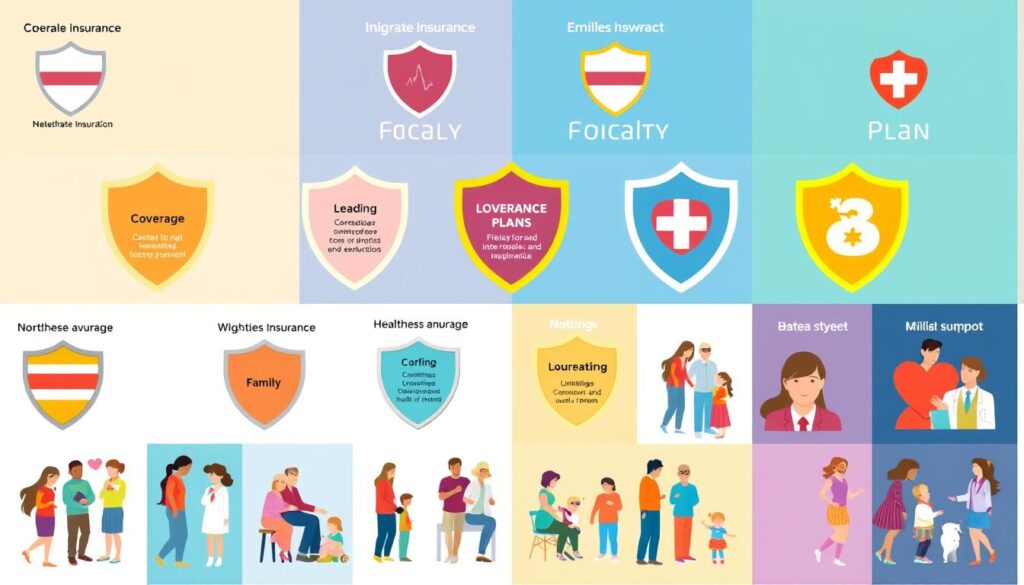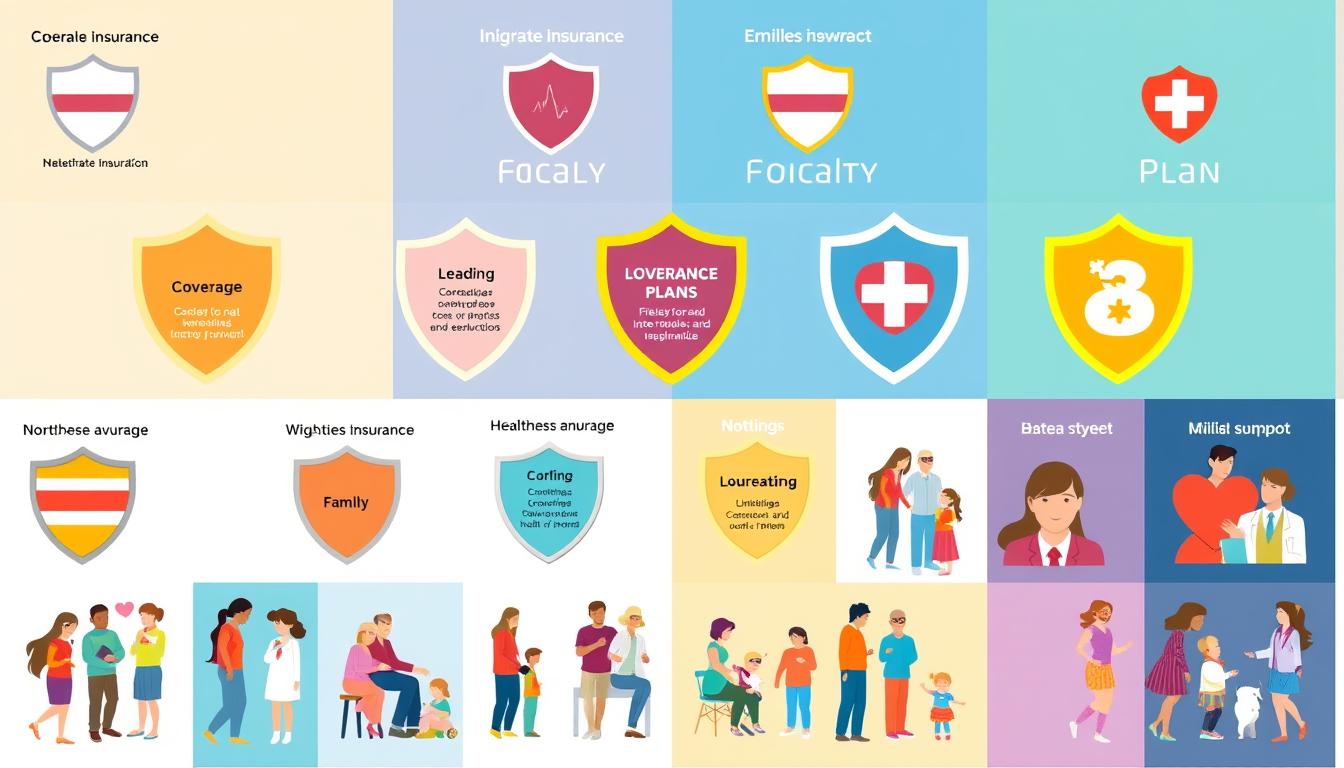Dealing with health insurance can be tough, especially for those with pre-existing medical conditions. These conditions can make it hard to get good coverage. Insurance companies look closely at your medical history and see the risks of covering someone with ongoing health issues.
It’s key to know about pre-existing condition policies if you’re looking for health insurance. You need to understand what conditions are considered pre-existing. Also, how they affect your insurance application and what medical documents you’ll need. This info is vital for keeping your health and finances safe.

Key Takeaways
- Pre-existing conditions can significantly impact an individual’s ability to obtain comprehensive health insurance coverage.
- Insurance providers assess the potential risks associated with insuring someone with a chronic or ongoing health issue.
- Understanding the types of pre-existing conditions and the impact on insurance applications is crucial for those seeking coverage.
- Medical documentation is often required to demonstrate the status and management of pre-existing conditions.
- Navigating the complexities of pre-existing condition policies is essential for protecting one’s health and financial well-being.
Understanding Pre-Existing Conditions in Healthcare Coverage
Pre-existing conditions are key when you’re looking for health insurance. They are medical issues you had before you applied for a new policy. Knowing how they affect your coverage is vital for getting the right care.
Common Types of Pre-Existing Conditions
Many chronic illnesses and medical problems can be pre-existing conditions. Here are some examples:
- Diabetes
- Asthma
- High blood pressure
- Cancer
- Arthritis
- Mental health disorders
- Cardiovascular diseases
Impact on Insurance Applications
Having pre-existing conditions can change how much you pay for insurance. Insurers look at your medical history to figure out the risks and costs. People with chronic illnesses might pay more, face treatment limits, or even get denied.
Medical Documentation Requirements
Applicants with pre-existing conditions need to share detailed medical records. This includes doctor’s reports and lab results. Insurers use this info to decide on coverage and what you’ll pay.
“Understanding the impact of pre-existing conditions is crucial for navigating the healthcare system and ensuring you get the coverage you need.”
The Evolution of Pre-Existing Condition Coverage in America
The healthcare system in the United States has seen big changes, especially in how we handle pre-existing conditions. Over time, new policies have changed how insurance companies deal with these conditions.
Before the Affordable Care Act (ACA) in 2010, insurance companies could deny coverage or charge more for people with pre-existing conditions. This made it hard for many to get affordable healthcare, blocking them from getting the medical care they needed.
The ACA changed this by stopping insurance companies from denying coverage or charging more for pre-existing conditions. This big change aimed to make sure everyone, no matter their health history, could get the healthcare they need.
The COVID-19 pandemic has made it even clearer how important it is to have good coverage for pre-existing conditions. The virus has hit hard on people with health issues, showing how crucial it is to have healthcare that includes everyone.
“The evolution of pre-existing condition coverage is a testament to the ongoing efforts to make healthcare more equitable and accessible for all Americans.”
Even with progress, the fight for better healthcare reform and insurance changes is still ongoing. People and groups are still trying to find a balance between helping those with pre-existing conditions and keeping the healthcare system financially stable.
As the healthcare world keeps changing, it’s key to keep the focus on protecting those with pre-existing conditions. Their rights and safety should be at the center of all policy talks and industry practices.
How Health Insurance Companies Evaluate Pre-Existing Conditions
Understanding health insurance can be tough, especially with pre-existing conditions. Insurance companies carefully check these conditions to decide on coverage and risks. This part explains how they do this, focusing on underwriting, risk evaluation, and coverage decisions.
Medical Underwriting Process
The underwriting process looks closely at your medical history and current health. Insurers ask for lots of information, like medical records and test results. They use this to find any pre-existing conditions and figure out the risks.
Risk Assessment Factors
- Severity and stability of the pre-existing condition
- Potential for future complications or exacerbations
- Impact on the applicant’s daily activities and quality of life
- Effectiveness and cost of necessary treatments or therapies
- Likelihood of increased healthcare utilization and claims
Coverage Decision Timeline
Deciding on coverage for pre-existing conditions takes time. Insurers usually make a decision within a few weeks after getting all the medical info. But, complex cases might take longer. During this time, applicants should stay patient and answer any extra questions they get.
“Understanding the insurance underwriting process and the factors that influence coverage decisions is crucial for individuals with pre-existing conditions to navigate the healthcare system effectively.”
This section helps readers understand how insurers check pre-existing conditions. Knowing this can help people make better choices and fight for their health care needs.
Navigating Health Insurance with Chronic Conditions
Living with chronic conditions makes managing healthcare and getting good insurance tough. But, with the right approach, you can handle it well. This way, you get the care you need for your long-term health.
Keeping your health insurance going without breaks is key. Look into employer plans, individual policies, or government programs like Medicaid or Medicare. This helps you get consistent, quality care and avoid issues with pre-existing conditions.
It’s also important to know what each insurance plan offers. Choose plans that let you see specialized doctors, cover important meds and therapies, and support long-term care.

Dealing with the healthcare system can feel overwhelming. But, there are resources and groups to help. They can guide you on your rights, explain your options, and even fight for you with insurance companies.
Stay informed, check out all your choices, and get help from experts and advocacy groups. This way, people with chronic conditions can manage their health needs well. They can also keep getting the specialized care they need.
Legal Protections for Individuals with Pre-Existing Conditions
In the United States, people with pre-existing health conditions have legal protections. These protections help them get affordable and full insurance coverage. They are key to protecting patient rights and regulating insurance.
Affordable Care Act Provisions
The Affordable Care Act (ACA), also known as Obamacare, changed healthcare a lot. It stops insurance companies from denying coverage or charging more because of pre-existing conditions. This law makes sure people with pre-existing conditions can’t be unfairly treated when looking for insurance.
State-Specific Regulations
Many states also have their own rules to protect people with pre-existing conditions. These rules often include guaranteed issue and limits on premium increases. It’s important for patients to know the laws in their state, as they differ a lot.
Appeals Process Rights
People who are denied coverage or face issues with their insurance because of pre-existing conditions can appeal. The ACA and other laws set out a clear appeals process. This lets patients challenge denials or limitations. Knowing their rights helps patients fight for the coverage they deserve.
“The legal protections for individuals with pre-existing conditions are essential in ensuring everyone has access to affordable and comprehensive healthcare coverage.”
Together, federal and state laws, along with the appeals process, form a strong legal framework. This framework protects the rights of those with pre-existing conditions. By understanding these protections, patients can confidently navigate the healthcare system and stand up for their healthcare needs.
Health Insurance Coverage Options and Limitations
Understanding health insurance with pre-existing conditions is key. There are many options to choose from. These include employer plans, individual market policies, and government programs.
Employer-sponsored insurance plan types often cover a lot. But, they might have policy restrictions or coverage exclusions for pre-existing conditions. It’s important to check the plan details carefully.
The individual insurance market gives more freedom. You can pick a plan that fits your needs. But, pre-existing conditions can affect policy restrictions and coverage exclusions. So, it’s crucial to research well.
Government programs like Medicaid and Medicare are great for those with pre-existing conditions. They usually offer more coverage. This means fewer policy restrictions and coverage exclusions.
“Navigating the health insurance landscape with a pre-existing condition can be complex, but understanding your options and limitations can help you make an informed decision.”
It doesn’t matter which insurance plan type you choose. Always review the policy restrictions and coverage exclusions carefully. This way, you can find a plan that covers your needs without breaking the bank.

Waiting Periods and Coverage Gaps for Pre-Existing Conditions
Understanding waiting periods and coverage gaps is key for those with pre-existing conditions. Insurance companies often have waiting times before covering pre-existing medical issues. These waiting periods can be long, making it hard to get continuous care.
Standard Waiting Period Durations
Waiting times for pre-existing conditions can be a few months to 12 months. This depends on the insurance plan and state laws. During this time, you might have to pay for all treatments yourself.
Coverage During Transition Periods
Switching health insurance plans can lead to gaps in coverage for pre-existing conditions. To handle these gaps, look into temporary health plans or gap coverage. These can help fill the insurance waiting times and keep your medical care uninterrupted.
It’s vital to understand waiting periods and coverage gaps for those with pre-existing conditions. By knowing your options, you can protect your health and finances.
Cost Implications and Premium Variations
Dealing with health insurance and pre-existing conditions can be tough financially. It’s important to understand insurance premiums, out-of-pocket costs, and financial planning. These factors help ensure you get the coverage you need.
Insurance premiums can change based on your medical history and the risk of your condition. It’s key to compare rates from different plans to find the best deal.
Out-of-pocket costs like deductibles, copays, and coinsurance can also be affected. You might pay more for treatments and meds related to your condition. These costs should be part of your financial plan.
Good financial planning is essential for those with pre-existing conditions. This means budgeting for medical bills, looking for financial help, and making sure your insurance covers your needs. By managing your finances well, you can lessen the financial impact of your condition.
“Navigating the complexities of health insurance and pre-existing conditions can be challenging, but with proper planning and research, individuals can find the coverage they need while managing the associated costs.”
Special Enrollment Periods and Qualifying Life Events
Getting health insurance can be tough, especially if you have health issues. Luckily, there are special times and life events that let you get or change your coverage. These times are outside of the usual enrollment periods.
Enrollment Windows
When a big life change happens, like getting married or having a baby, you can get a special enrollment period. This usually lasts 60 days. It lets you sign up for a new insurance enrollment plan or change your current one.
Documentation Requirements
- To use these special life changes and coverage opportunities, you need to show proof of the event. This could be a marriage certificate or a job loss notice.
- The exact documents needed can change based on your situation and the insurance company. So, it’s key to check the rules and get all the right papers.
Knowing about enrollment times and what documents you need helps those with health issues. It ensures they get the coverage they need, even with unexpected life changes.
“Navigating the healthcare system can be challenging, but knowing your rights and options can make all the difference.”
Managing Pre-Existing Conditions Under Different Insurance Plans
Dealing with health insurance can be tough, especially for those with pre-existing conditions. But knowing the differences between plans can help you choose wisely. This way, you can get the coverage you need.
When looking at HMOs, PPOs, and HDHPs, the plan comparison is key. HMOs have a smaller network but are often cheaper. PPOs let you see more doctors but cost more each month. HDHPs are cheaper but you pay more before insurance kicks in.
Doing a deep benefits analysis is vital when picking a plan. Some plans cover certain conditions better, like mental health services. Make sure your doctors are in the plan’s healthcare networks to avoid high costs.
“Choosing the right health insurance plan is a critical step in managing pre-existing conditions, as it can directly impact the quality and affordability of your healthcare.”
Understanding the pros and cons of each plan helps you make a smart choice. This careful approach ensures you get the right care for your needs and budget. It helps you manage your health conditions better.
Conclusion
Exploring health insurance with pre-existing conditions is complex. It needs careful attention, patience, and a good grasp of your rights and choices. The rules and laws keep changing, so it’s crucial to stay alert.
Knowing about the medical review process, how long it takes, and the costs helps you make better choices. Also, being aware of special times to sign up and life events can keep you covered during changes.
Being proactive and advocating for yourself is essential when dealing with pre-existing conditions. Understanding your options, what’s limited, and the legal protections you have helps. This way, you can move through the healthcare system with confidence and get the coverage you need.
FAQ
What are pre-existing conditions and how do they affect health insurance coverage?
Pre-existing conditions are health issues someone has before getting a new health insurance plan. These conditions can affect how easy it is to get coverage or how much it costs. Insurance companies look at these conditions when deciding if you can get coverage and what it will cost.
What are some common examples of pre-existing conditions?
Common pre-existing conditions include diabetes, heart disease, cancer, asthma, mental health issues, and autoimmune diseases. These conditions often need ongoing care and treatment, which insurance companies consider.
How has the treatment of pre-existing conditions evolved over time in the United States?
The way pre-existing conditions are treated in the U.S. has changed a lot, especially with the Affordable Care Act (ACA) in 2010. Before the ACA, insurance companies could deny coverage or charge more for people with pre-existing conditions. The ACA made it so insurers must cover everyone, no matter their health history.
What is the medical underwriting process that insurance companies use to evaluate pre-existing conditions?
Insurance companies thoroughly check an applicant’s medical history during the underwriting process. They look at doctor’s records, tests, and treatments to figure out the risk. This helps them decide what coverage and rates to offer.
What legal protections are in place for individuals with pre-existing conditions?
The Affordable Care Act (ACA) gives big protections to people with pre-existing conditions. It stops insurance companies from denying coverage or charging more based on health history. Many states also have their own rules to protect these individuals.
What are the different health insurance options available for individuals with pre-existing conditions?
People with pre-existing conditions have several insurance options. These include plans from employers, individual market policies, and government programs like Medicaid and Medicare. Each has its own benefits and rules for pre-existing conditions. It’s important to compare them to find the best one.
How can individuals manage coverage gaps and waiting periods for pre-existing conditions?
Insurance companies often have waiting periods for pre-existing conditions, causing gaps in coverage. To fill these gaps, people can look into COBRA, temporary plans, or coverage through a family member’s plan. Keeping coverage continuous is key to avoiding gaps and ensuring access to healthcare.
What are the cost implications and premium variations for individuals with pre-existing conditions?
Pre-existing conditions can make insurance more expensive. Companies might charge higher premiums or have higher deductibles and copays. But, the exact costs depend on the plan, coverage, and medical history.
How can individuals with pre-existing conditions navigate the special enrollment periods and qualifying life events?
People with pre-existing conditions can sign up for plans outside of regular open enrollment if they have certain life events, like losing a job or getting married. Knowing about these special periods and what documents you need is important for getting the right coverage.
